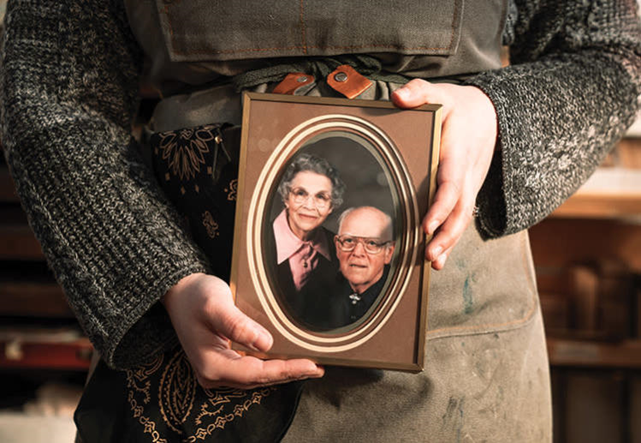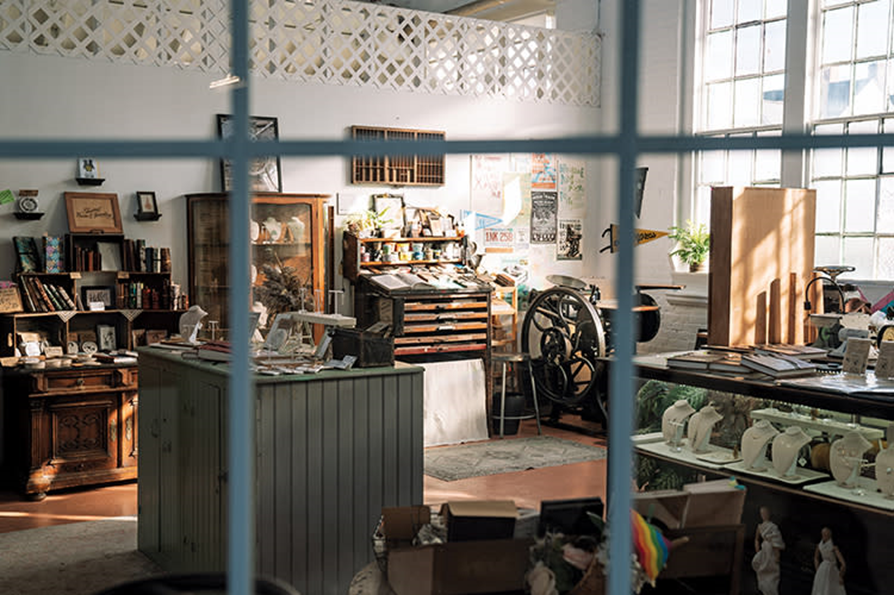
Shuttle Press & Bindery featured in WHERE Women Create Magazine
I have ink in my blood.
I know that sounds crazy. The truth is: Sometimes we’re destined to find our way down a particular creative path. Ask anyone who has known me since I was young, and they’ll tell you that I’ve always been an artist. No matter where I was or what I was doing, I was always finding ways to explore my artistic talents. Naturally, when the time came for me to pursue a college education, I found myself drawn to art school.

Nestled within the bowels of my college’s main building were my school’s printmaking lab, letterpress studio and bookbinding classrooms. Little did I know at the time that these art forms would grab ahold of me and not let go!
Something about the feeling of paper as it creased beneath my fingertips — the smell of the syrupy inks, the rhythmic babble of the antique printing presses springing to life — all of it resonated deeply within me. By graduation, I had fallen completely in love with letterpress and bookbinding — art forms that have long been integrated.

At this time, there were moments when I found myself in a bit of an artistic crisis. Up to this point, my studies had centered around my majors: graphic design and illustration. I felt like I had been too rigid and practical in the pursuit of my education, neglecting a deep-rooted part of me. Through this exploration, that part of me had finally bloomed.
Soon thereafter, I came to learn that my great-grandfather was a hobby pressman. By some miracle, his 1940s tabletop letterpress had been tucked away in my grandmother’s basement, waiting to be rediscovered! I will never forget the moment I was introduced to that dusty, cobweb-strewn press that had been lying dormant for so many years.

Restoration was an exciting and sentimental project. I was lucky to find that she still had almost all of her parts and pieces. My biggest investment was having her rollers re-made, as they had deteriorated quite badly over time. I decided to name the press “Imogene” in my great-grandmother’s honor. Ink truly had been running through my bloodline, and it was my turn to revitalize the craft.
And so it was that my business was born. Shuttle Press & Bindery sprang to life through an interest shared across four generations. At first, I worked with Imogene in my cramped Boston-area apartment, printing coasters, business cards, stationery and other ephemera. I sold my handcrafted books part time at craft fairs and pop-up art shows, and online.

Things started slowly, but the momentum behind my business amplified during the pandemic. Having been laid off from my full-time design job, I took the opportunity to focus on what fulfilled me. The response to my work was overwhelmingly positive — people were hungry to purchase something unique, timeless and of heirloom quality.
Shuttle’s next home was my grandmother’s barn, in the old milk room. My time there was very brief, but provided enough extra space to invest in a much larger press. Capable of producing superior prints at a faster rate, this human-powered press I named “Frida” was manufactured in the late 1800s, and weighs a whopping 1,200 pounds.
Today, my studio is nestled in the small seaside community of Stonington Borough, within a historic building called The Velvet Mill. So named for the luxury fabrics it once produced, the mill is now a hidden gem containing a vibrant community of creatives, artisan makers, eateries, wellness services and more. It was originally constructed in 1888, making it about as old as my oldest printing press.
The building has a personality all its own, with a maze-like interior, soaring saw-tooth skylight windows, industrial beams and sturdy brickwork foundation. It’s cold in the winter, hot in the summer and full of gorgeous natural light year-round!
As you pass through the French doors of the studio, you’ll notice tall windows on the far brick wall. Over the years, many of the panes have been broken and replaced, giving them a charming mismatched feel. Just in front of the windows are my two largest presses, Frida and Molly. Not only does this area of the shop provide me with the best natural light to work under, it also encourages people to enter the space. It’s hard to resist the urge to journey across the studio when you see Frida’s flywheel in motion!
Adjacent to the presses, I have shelves of paper storage: luscious white cotton paper for greeting cards, stationery and wedding invitations, as well as envelopes in a rainbow of colors. Others hold sleeves of blank coasters, along with wooden postcard and bookmark blanks. One of my oldest pieces of furniture is a bit of a catchall, containing larger sheets of paper, cleaning supplies and oil, lead typefaces and a shelf with inks in a spectrum of colors. I also use this space to decorate with inspiring knickknacks and an old typesetter’s catalog for guests to flip through. I’ve always been a bit of a maximalist and I think it shows in my space.

Opposite the presses, you’ll find my bookbinding workbench — an old dining room table that I’ve repurposed. Atop the bench are a variety of threads, needles, cutting tools, and cubbies filled with reference books and miscellaneous supplies. This particular area of my studio is pretty much always in chaos, but it helps me immensely to have everything I need close at hand.
Towards the left of the bookbinding bench, you’ll find my “paper wall,” another instance of repurposing. This time, it’s an over-the-door shoe caddy that cradles all my imported, marbled and screenprinted papers. This area of the shop seems to be one of the most magical for many of my visitors, a true feast for the eyes!

A small window in the corner of the shop allows visitors in the hallway to peek through and see what I’m working on — gazing in just atop my copy-presses. By the second set of French doors you’ll find my beloved Imogene, perched atop a rolling storage cart. Beside her is another small press and a collection of antique irons. These little irons make excellent weights when sewing books or drying projects under weight. This area also houses a photograph of my great-grandparents so that they can keep a watchful eye.
Throughout the rest of the studio, I have intimate retail spaces where shoppers can purchase my books, cards and other handcrafted items. I try to keep things organized in such a way that is friendly, but also generates a sense of exploration. Visitors are encouraged to touch and feel my products — a meaningful part of the customer experience in an increasingly digital world. My books are not mass-produced paper goods like the big box stores — each is crafted with care using gorgeous leathers and papers. My wares bridge the gap between art and utility, creating lovely bespoke items that are a pleasure to look at, and to use.

The studio space is inspiring — not only because it affords me a place to house my presses and create, but because it speaks to the very foundation of my business: history. To work on these old presses within an equally old building reminds me that things made well are destined to last. We live in an increasingly disposable world, so it’s more important than ever to turn back to tradition. Handcrafted goods not only bring us joy, but act as heirlooms for future generations.
I feel a deep sense of satisfaction in continuing these antiquated traditions and educating people along the way. Though not a primary function of my workspace, I do have a few small plaques set around the room with information about the presses and equipment. It’s like a mini museum — but instead of being sequestered behind plexiglass, it’s a living, breathing, actively functioning space.
By contrast, I’m fiercely proud of the ways in which I’ve broken tradition. Both letterpress and bookbinding have historically been male-dominated spaces. I’m honored to be a queer woman working in this field. Letterpress printing, in particular, has changed quite dramatically over the last century, becoming less utilitarian and more luxury. Gone is the idea that ink should only kiss the surface of the card. Clients today are seeking a deep, tactile impression that bites deep into the paper’s surface, setting this method apart from digital printing.

My ultimate dream is to have a stationery shop downtown — a bright and inviting space where window shoppers can see the presses in action, take a class, or pop in to buy a greeting card for someone special. I’d love to have an area for client meetings, as well as more space for teaching workshops.
At my core, I want to ensure that my studio space is a safe and welcoming environment for everyone — so that others can also fall in love with paper.
Images


